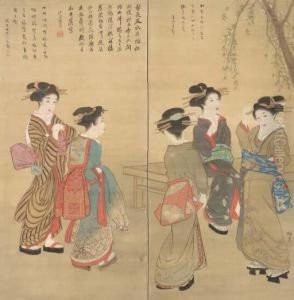Nishimura Nantei Paintings
Nishimura Nantei was a prominent Japanese painter and poet active during the late Edo period. Born in 1775 in Edo (present-day Tokyo), Nantei was part of a cultural era in Japan that was rich in artistic innovation and expression. He is particularly noted for his contributions to the Nanga (Southern painting) school of Japanese painting, which looked to Chinese literati painting for inspiration and emphasized the importance of personal expression and the integration of poetry, calligraphy, and painting.
Nantei’s artistic lineage traces back to the Chinese literati tradition, which he adapted to Japanese tastes and sensibilities, creating works that were deeply imbued with the Japanese spirit yet reflective of Chinese aesthetic principles. His paintings often featured landscapes, flowers, and birds, executed with a delicate touch and a profound sense of lyrical beauty. Nantei was also an accomplished poet, and his artworks frequently included inscriptions of his own poetry or classical Chinese verses, blurring the lines between visual and literary arts.
Throughout his career, Nantei was actively involved in the cultural circles of Edo, collaborating with other artists and intellectuals of his time. His works were highly appreciated for their refined elegance and poetic sensitivity, and he played a significant role in the development of the Nanga movement in Japan. Despite the political and social changes occurring in Japan during his lifetime, Nantei’s art remained a testament to the enduring appeal of the literati ideal, emphasizing scholarly learning, artistic skill, and a deep connection to nature.
Nishimura Nantei's legacy is preserved in various collections and museums in Japan and around the world, where his paintings continue to be celebrated for their beauty and historical significance. He passed away in 1834, leaving behind a body of work that continues to inspire appreciation for the Nanga tradition and the broader cultural heritage of Japan.

![Nantei Gafu Kohen [the Drawing Book Of Nantei]](https://www.niceartgallery.com/imgs/849708/s/nishimura-nantei-nantei-gafu-kohen-the-drawing-book-of-nantei-a4f9ab77.jpg)